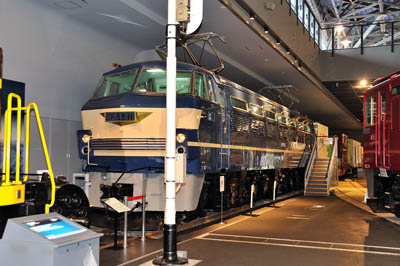
Electric Locomotive
Class EF66 |
A high powered DC Electric Locomotive for arterial line use as a freight limited express train. |

|
|
Until the 1950's, Japan's rail freight transportation system was only used as a Yard-Transportation system. The Yard-Transportation System means that freight trains go to a destination while repeating train switching on yards. Therefore, it usually took a long time for a freight train to arrive at a destination.
JNR took this occasion for a planned 100 Km/hr freight limited express train, and started mass-production of high speed container freight cars. This freight limited express was started on the 1st of October 1966 with double-headed Class EF65. But double-headed engine operation was inefficient compared to single engine operation, therefore, more high powered engines were needed that would be capable of pulling 1,000 tons at 100 Km/hr. From the project, a 3,900Kw EF90 was the most powerful prototype electric locomotive and came upon the scene during September 1966, and test working was often repeated during the year. The appearance of the EF90 was a renovated streamline form, from the existing Japanese electric box body.
Afterward, 34 engines were manufactured during 1973, with a total of 56 engines. However, this increased production of EF66s, were also used as class B freight trains. (95 Km/hr) Later during 1974, they were used as local freight trains on the Tokaido and Sanyo lines. On the 14th of March 1985, a few EF66s were transferred as passenger limited express trains. The Hayabusa, Sakura, Mizuho and Fuji ran between Tokyo and Shimonoseki. The reason for increased passenger train operation, was because of the reduction of freight trains, and the increased weight of passenger limited express trains. With division and privatization of JNR, EF66's No.1-39 and No.901 were transferred to the Japan Freight Railway Company, and No.40-55 were transferred to JR-West. Afterward during 1989 JR-Freight increased production with partial design change with 33 EF66s(No.101-133). During 1999-2002, four EF66s No.41,44,52 and 54 were transferred from the JR-West to the JR-Freight. The culling of the EF66 began during 2001. However during those days, sixty-eight of Suita's EF66 were still active between Tokyo and Shimonoseki on the Tokaido and Sanyo lines, and between Soga and Kuroiso on the Sobu and Tohoku lines. Ten of JR-West's EF66s were deployed to the Shimonoseki depot for passenger limited express, but they were retired during the 14th of March 2009.
|
|
Preserved engine EF66 No.11 (1968 - 2007)
Preserved EF66 No.11 was manufactured at the Kawasaki Rolling Stock Co., and it's manufactured number was 390 on the 12th of August 1967. She was deployed on the Shimonoseki depot and active mainly on the Tokaido and Sanyo line. She was moved to the Hiroshima depot during July of 1979 and later, during January 1984, she was transferred to the Suita depot in Osaka. Later she was active from the Suita depot during 2006, she then went into reserve and was moved to the Hiroshima depot and was kept for safekeeping at the JR-Freight Hiroshima depot. She was later transferred to the JR-East and exhibited at the Saitama Railway Museum during May of 2007. |
|
Class EF66, No.11 Biographic Data Chart
| ||||||||||||||||||||||||||||||
|
Introduction |
Go to Top |